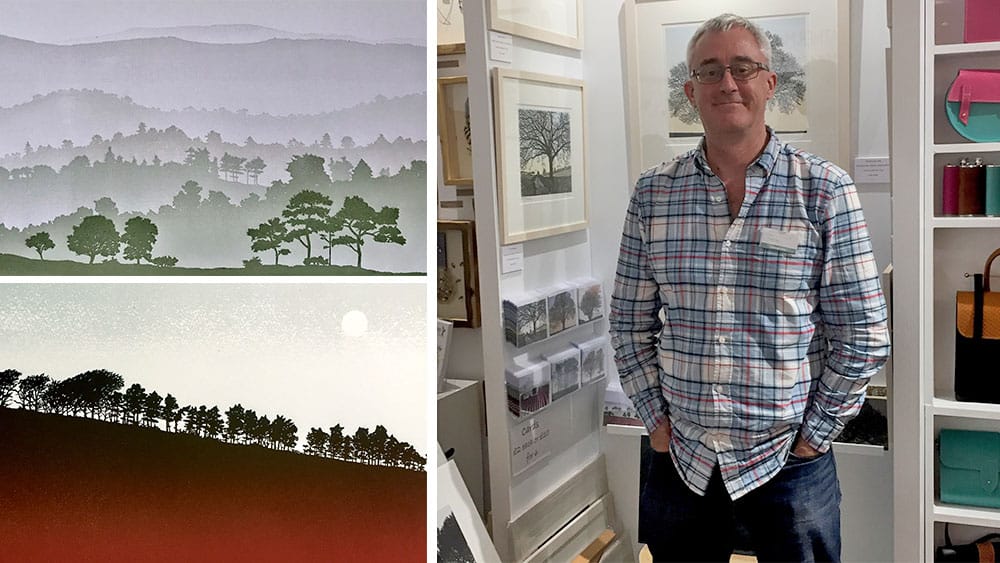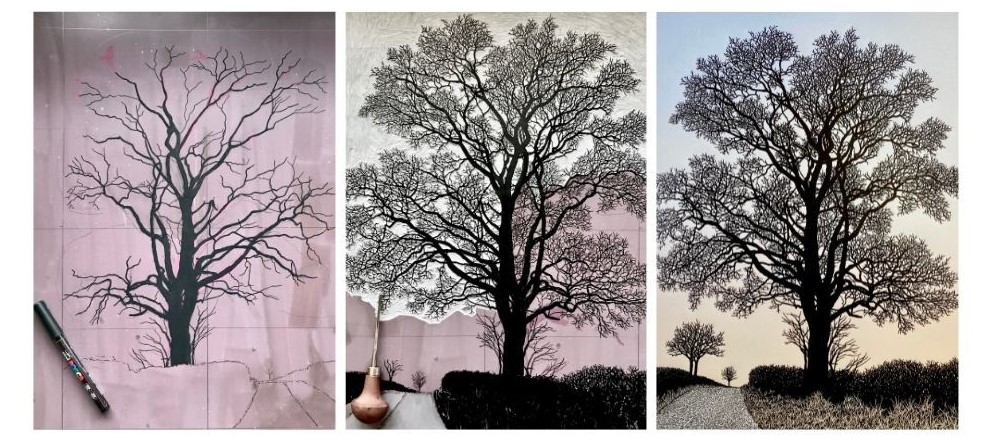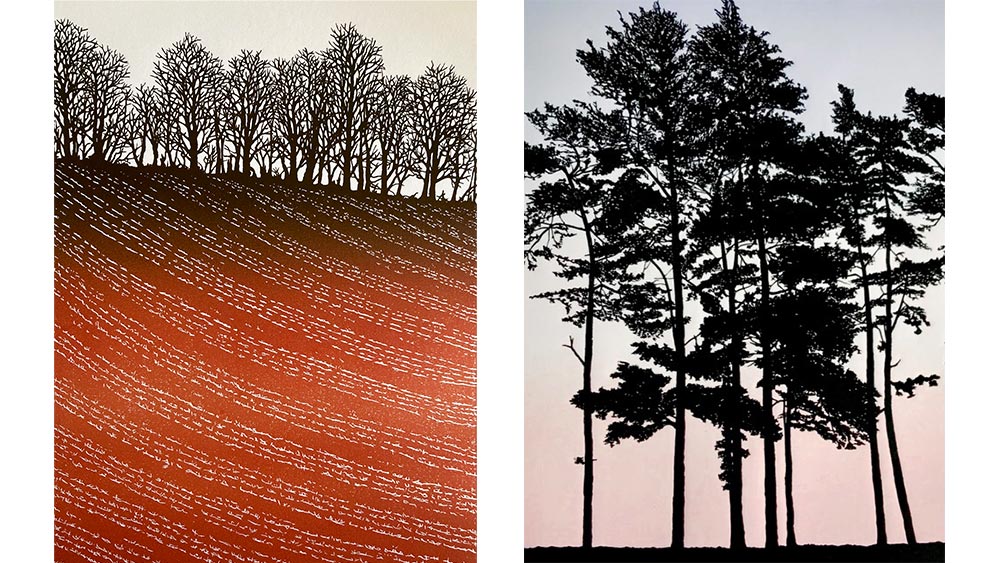Q & A with Richard Shimell
South Devon printmaker, Richard Shimell, is a man with a passion for trees. From his studio on the leafy edges of Dartmoor he can be found sketching his latest print designs sold in galleries across the region. But his introduction into printmaking didn’t follow the usual route, it was a spur of the moment enrolment onto a workshop that had him hooked.
Drawn towards what he describes as the graceful presence of trees, he’s now a master of his trade. We caught up with Richard to find out more about his work and the secrets behind it.

What led you to the world of printmaking?
I have no art background, but was between freelance journalism jobs in 2010 when my neighbour mentioned she was going to a printmaking workshop at Dartington. I only knew what printmaking was because I’d recently visited the open studio of a linocut printmaker and had been fascinated by the process.
I told the man who ran the workshop that I knew nothing and would need a lot of help! He just said: “Come along”, so I did, and ended up going for a day a week for six years.
It was very difficult for quite a while, as I really knew absolutely nothing. There were lots of headaches – literal and metaphorical, but it eventually got easier and I was very determined because I felt like I’d discovered the thing I’d been looking for all my life.
How much does the landscape of Dartmoor inspire your art?
We’re accustomed to thinking of the Dartmoor landscape as moorland, but around the edges of the moor are the most amazing woodlands and farmland studded with veteran trees. I live in that landscape and find most of my trees there. In many ways it is the most interesting and vibrantly diverse part of the national park.
I like the open spaces, but the intensively sheep-grazed moor is a barren place. It would be so amazing if the remaining woodlands could be allowed to spread on to it, at least a little.
Could you tell us more about your fascination with trees?
Who doesn’t like trees? I love their graceful presence, huge and all around us, like everyday elephants. I love them leafy and leafless, but am particularly drawn to their winter shapes. Each one is unique, but follows a pattern of growth peculiar to its species.

There are so many different shapes – the same oak sapling could take many forms, depending on where it grows. In a sheltered field it can spread out into a luxuriant fan, whereas constrained in a hedge or line of trees, it might be forced up into a tall and narrow shape.
How do you set about capturing a tree’s spirit and character in print?
I mostly try to replicate what I see in a simplified way, but I have to make adjustments for depicting trees in silhouette. A branch with a strange shape can look characterful in reality, but reduced to a silhouette, it can look wrong and confusing. I also have to edit out some of the branches on the other side of the tree, to make the image more two-dimensional, as otherwise there would be odd-looking areas of dense black where multiple branches cross.
Describe to us the processes behind your printmaking?
My main method is to draw on to a piece of the vinyl flooring I prefer to use, then carve out the background to leave the tree in relief. I use vinyl flooring rather than lino as it cuts more cleanly and is harder and more durable. Its density is somewhere between lino and wood. I get it from a business which lays floors and is left with offcuts and remnants it has to dispose of. So I think of it as a kind of recycling, saving it from going to landfill.
It can take me a week to draw the image of the tree, then up to a month to carve it. Once it’s ready, I need to apply ink to it. I use printmaker’s ink, which has a consistency like clotted cream. I spread a line of it on a glass slab then roll over it with a giant roller. The aim is to get the roller evenly coated with ink, then roll that over the carved tree plate, inking the tree and not the cut-away background.
Once inked, I place the tree plate on the bed of my press, place paper on top and turn the handle to push the bed between the metal rollers of the press, a bit like feeding a sheet into a mangle.

It’s easy to go wrong! Too little ink and the tree is patchy. Too much and the little branches turn into blobs. Too little or too much pressure on the press can cause the same problems.
I add a colour background with a separate plate the same size, inked and printed first, then the tree plate printed on top. Every print is made in this way, by hand, so each one is an original
How do the seasons shape your work?
I do most of my carving work in the winter, as I enjoy lighting the fire and settling down with the radio and my emerging tree on a gloomy afternoon.
The winter is also the time I’m out looking for trees and landscapes that spark excitement and an urge to make them into prints.
What is the Devon Guild of Craftsman and how has it influenced your career as an artist?
The Devon Guild, now renamed Make South West, is a wonderful craft education charity with galleries and a shop in an old mill at Bovey Tracey. Printmakers, potters, jewellers etc in the South West can apply to become members and sell their work there.
Becoming a member helped me sell more prints and find other galleries to stock my work, as membership was a stamp of approval by an organisation respected across the country.

Where are some of your favourite walks on Dartmoor?
I have so many! I love the woods and wild River Dart at Newbridge near Holne, the woods, heaths and moor between Lustleigh and Manaton on the eastern edge of the national park, and the ancient Black-a-tor upland oak wood south of Meldon reservoir in the north west.
What can our guests expect from a day out on the moors?
A sense of wildness you don’t get in many other places in southern England, even if it’s not as wild as it looks, as well as a feeling of space and the right to roam.
Why is Dartmoor such a wonderful setting for an art retreat?
If you’re interested in depicting landscapes it would be hard to find anywhere with so many different and beautiful types – moorland, woods, rivers, tors, ancient field patterns, farmland and some magnificent trees.
Take a look at our holiday cottages on Dartmoor
